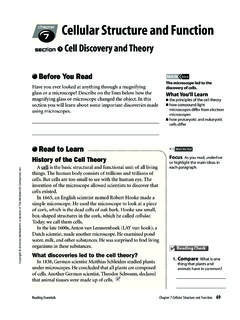Transcription of Structure and Function of the Musculoskeletal System
1 Professor Alan Hedge, Cornell University, August 2013. Structure and Function of the Musculoskeletal System Professor Alan Hedge DEA 3250/6510. functions of the Musculoskeletal System Support and protect the body and its organs. Provide motion. Musculoskeletal System : Major substructures Tendons. Ligaments. Fascia. Cartilage. Bone. Muscle. Joints - allow motion between body segments. Connective Tissues Cells. Extracellular matrix: z Fibers: Collagen Elastin z Ground substance. Connective Tissue Cells Fibroblasts- cells producing the matrix for skin, tendons and ligaments. Chrondrocytes - cells producing the matrix for cartilage. Osteocytes - cells producing the matrix for bone.
2 1. Professor Alan Hedge, Cornell University, August 2013. Connective Tissue Matrix Collagen fibers: z Type I - tendons, ligaments, bone, skin. z Type II - cartilage. z Type III - blood vessel walls. Mechanical properties depend on fiber types and fiber arrangements. Tendons Ligaments Fascia Mechanical Properties of Fibers Stress - force on a fiber weight. Strain - % stretching of fibers. Elastic limit - point at which the elasticity of the fiber is lost. Failure - point at which the fiber breaks. Collagen Collagen molecule - a triple helix of three extended protein chains wrapped around one another. Numerous rodlike collagen molecules cross-link together to form unextendable collagen fibrils.
3 Collagen fibrils are striped because of the regular repeating arrangement of the collagen molecules within the fibril. Collagen fibers Strength of collagen is 50% strength of bone. Under tension, collagen fibers first elongate slightly and then become increasing stiff until failure. Collagen fibrils have the tensile strength of steel. Elastic Fibers Elastin - polypeptide chains cross-linked together to form rubberlike, elastic fibers. Elastin molecule uncoils when the fiber is stretched and spontaneously recoils when the stretching force is relaxed. Elastic fibers Weak and brittle fibers. At low loads they strain greatly and can increase ~200% in length before failure.
4 2. Professor Alan Hedge, Cornell University, August 2013. Tendon Structure Tendon Tendon sheath: z Synovium - lubricant producing tissue. z Synovial fluid - lubricant fluid. Tendons and Ligaments At certain points, ligaments surround parts of the tendon sheath to act as: z Pulleys retinaculae that keep tendons attached to joints when muscles contract z Tendon guides retinaculae that restrict lateral tendon movement Ligament attachments allow tendons to work around corners, as in the fingers and toes. Tendons Tendons connect muscle to bone to create movement. Collagen in Tendons Tendons comprise parallel bundles of collagen fibers, with few elastic fibers and ground substance.
5 Finger Movement Tendon and Muscle Muscle fiber wrapped in endomysium Fibers bundled into fascicles (up to 200 fibers) wrapped in perimysium Fasciculi bundled together and interspersed with blood vessels and nerves in muscle and wrapped in epimysium Epimysium and perimysium tissues taper at each end to form tendons Cartilage: 3 types Hyaline cartilage z Solid matrix, cells (chrondrocytes) densely clustered z present in the growth plates at the end of bones and on the articular surfaces of joints. Also present in the respiratory tract ( trachea). Fibrocartilage z solid matrix, cells widely interspersed among collagen fibers z present in intervertebral discs, Elastic cartilage z solid matrix, cells in small groups between many elastic fibers z present in ears, nose, epiglottis etc.
6 3. Professor Alan Hedge, Cornell University, August 2013. Bone Adult human skeleton has 206 bones. Babies born with ~ 300 bones but fusion occurs as a child develops. 99% of bodies calcium is in bone. 80% of bone tissue by weight is minerals. Longest bone (femur). Smallest bone (stapes). Males have slightly thicker and longer legs and arms Females have a wider pelvis and a larger pelvic cavity Bone groups Axial skeleton (80 bones). z skull (29 bones). z thorax (25 bones). z vertebrae (33 bones). z Auditory ossicles z Hyoid bone Appendicular skeleton (126 bones). z pectoral girdle (4 bones). z upper extremity (60 bones). z lower extremity (60 bones).
7 Z and pelvic girdle (2 bones). Long bones Round bones comprising: z diaphysis - shaft z epiphyses - 2 expanded ends Bone Structure and Growth Ossification - processes of bone formation. z Osteoblasts - cells that form the bone matrix. They transform into z Osteocytes - cells isolated inside the mineralized bone matrix. z Osteoclasts - cells important to bone remodeling. Types of Bone Cancellous (spongy) bone - less dense bone tissue found at the epiphyses of the long bones and in axial bones, such as the skull. 30-90% porosity. Cortical (compact) bone - tissue with high proportion of bone. 5-30% porosity. Anisotropy All bone is anisotropic ( its mechanical property changes when loads are applied in different directions).
8 4. Professor Alan Hedge, Cornell University, August 2013. Bone: Mechanical properties Most important properties are strength and stiffness of bone. Fractures occur when the bone is loaded to failure. Compression fractures are commonest in cancellous bone ( fractured skull). Bending and torsional fractures are commonest in cortical bone ( broken tibia). Speed of loading to fracture. Human Muscles Muscular System is 50% of total human body weight. >600 skeletal muscles, which enables the human body to move and stand erect. Skeletal muscles are arranged in overlapping intricate layers: z Superficial muscles z Deep muscles Skeletal muscle Skeletal muscle is striated (striped), and excludes cardiac and smooth muscle.
9 Skeletal muscle is under voluntary control. Each muscle is a separate organ. Each muscle is attached to bone by tendons that cross one or more joints. Generally, skeletal muscles generate moments about joints. Muscle fibers Long, cylindrical cells containing multiple nuclei. Most of the fiber volume is occupied by the contractile elements - myofibrils. Myofibrils show a banding pattern (transverse striation) of thick myofilaments (myosin) and thin ones (actin). The contractile unit of the myofibril is called the sarcomere. Structure of Skeletal Muscle Skeletal muscle is covered by a fascia called the epimysium. The epimysium penetrates and subdivides the muscle into muscle fiber bundles called the fascicles (fasciculi).
10 Each fascicle is covered by connective tissue called the perimysium. Each individual muscle fiber is covered by connective tissue called the endomysium. 5. Professor Alan Hedge, Cornell University, August 2013. Connective tissue provides pathways for nerves and blood vessels + contributes to the mechanical properties of the muscle. Skeletal Muscle Structure Actin & Myosin filamentary protein molecules form the sarcomeres, and these bundle to form myofibrils, which bundle to form muscle fibers. Longest fibers ~30 cm long, mm wide, and contain several thousand nuclei. Motor Units Motor unit - group of muscle fibers innervated by branches of the same efferent neuron.













